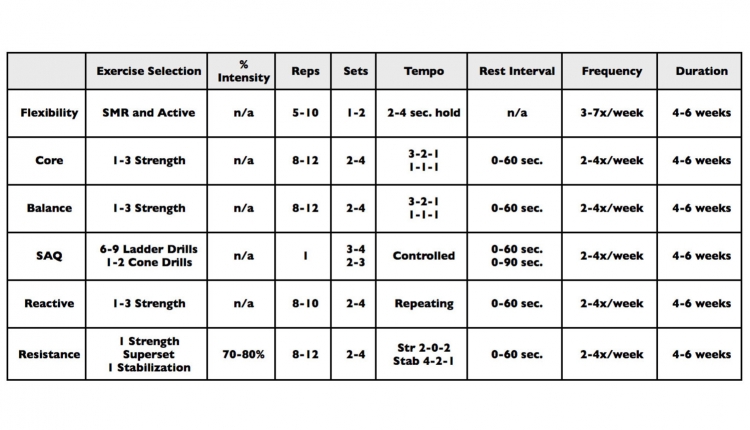Now that 2013 is in full swing, you should be experiencing a surge in your momentum as a direct result of the amount of goal setting and planning you did last year in preparation for this year. Established clients should be continually progressing, and newer clients should be witnessing exciting results and be amazed at how much they are learning from you. This is the perfect time for you to look ahead to what is unfolding before us this year. I am, of course, referring to the coming changes to our healthcare system and access to needed services. Now is the time to determine whether you are prepared professionally for all the possibilities these changes may bring about, and the resulting impact they may have on your career!
Ask yourself these questions:
1) How well does my current skill set serve the majority of my clients?
2) Are there any special populations I am not presently serving due solely to the lack of specialized training or certifications?
3) If one (or more) of my clients were to be sidelined by an injury, would I be capable of helping them once they received medical clearance to return to fitness training?
"Out there things can happen, and frequently do, To people as brainy and footsy as you." In his book, Oh, the Places You'll Go!, (1990:Page 8), Dr. Seuss so aptly expressed the reality that the unexpected often does happen. No one plans on getting sick or injured, certainly none of your clients! After all, they already value health and fitness, and are working hard to increase their levels. But, what if something did happen to one or more of them? What, if any, would your role be in their recovery process? A unique population of clients exists, whom you may not be serving, but perhaps should be. That population consists of people who have experienced an injury (or illness) of some sort, and following the appropriate medical care and/or physical therapy, still have not achieved a full recovery, but have unfortunately exhausted all available medical care options or reached their maximum limits for service. This is where a more qualified personal trainer can step in to help the client reach their recovery goals, and reclaim their desired quality of life, but only if they hold the right credentials. I believe that with the pending changes to our healthcare system, we are quickly becoming a new option for service in the continuum of healthcare for our clients.
We are not doctors; we do not diagnose or treat illness, disease or injuries. Physical therapists are limited to working with only the affected part(s) of the body as prescribed in a doctor's orders. Because personal trainers are able to address the entire kinetic chain, our work is an integral part of the rehabilitation process. And those fitness professionals who hold specializations in post-rehabilitation, corrective exercise, biomechanics and muscle imbalances are able to position themselves as key players in the rehabilitation process because they are trained to understand the conditions leading to injuries, the different surgical techniques used, post-surgical complications and what their specific role is in the rehabilitation process. Specifically, they are able to lead the client to the end of their journey to recovery through the implementation of the appropriate corrective exercise strategies for impairments of the foot, ankle, knee, limbo-pelvic-hip complex, low back, shoulder, etc. Using any one or all of these various techniques: self-myofascial release, static stretching, positional isometrics, and integrated dynamic movements, makes the trainer’s contributions invaluable to a client's recovery efforts.
In the early years of my career, I worked an incredibly large number of sessions each week training sick and injured people that other trainers wouldn't, or couldn't. This special population helped grow my business dramatically, but more importantly, provided me with a much deeper level of experience and skill than I would have otherwise achieved. Additionally, I developed a keen appreciation of the majesty of the human body -- what it can endure and what it is capable of. I encourage you to make the time this year to obtain the advanced credentials that will allow you to assist existing or new clients to reclaim their quality of life. Many options exist for trainers to gain advanced credentials. Some examples are: *CES (Corrective Exercise Specialist) from the National Academy of Sports Medicine (NASM); *NCHPAD Specialist through the American College of Sports Medicine (ACSM) in collaboration with the National Center on Health, Physical Activity and Disability; *Certified Special Population Specialist (CSPS) through the National Strength and Conditioning Association (NSCA); and, *Orthopedic Exercise Specialist through the American Council on Exercise (ACE).
As the details of our new healthcare system are unveiled, it is likely that patients will be asked to assume greater responsibility for their recovery process. Become an innovative health and fitness professional with the knowledge and skills to effectively bridge whatever gaps might exist in the continuum of care your client needs and expects. Keep in mind that we are more than trainers; we are Certified Health and Personal Fitness Experts.
Valorie Ness is CEO of Catalyst Fitness Midtown located in Atlanta, Georgia. She has been in the industry for over 15 years and travels nationally and internationally as an educator and Presenter. Valorie is the 2013 PFP Trainer of the Year, Master Trainer for ACE, Red Cord and Catalyst Fitness. www.catalystfitness.com
Ask yourself these questions:
1) How well does my current skill set serve the majority of my clients?
2) Are there any special populations I am not presently serving due solely to the lack of specialized training or certifications?
3) If one (or more) of my clients were to be sidelined by an injury, would I be capable of helping them once they received medical clearance to return to fitness training?
"Out there things can happen, and frequently do, To people as brainy and footsy as you." In his book, Oh, the Places You'll Go!, (1990:Page 8), Dr. Seuss so aptly expressed the reality that the unexpected often does happen. No one plans on getting sick or injured, certainly none of your clients! After all, they already value health and fitness, and are working hard to increase their levels. But, what if something did happen to one or more of them? What, if any, would your role be in their recovery process? A unique population of clients exists, whom you may not be serving, but perhaps should be. That population consists of people who have experienced an injury (or illness) of some sort, and following the appropriate medical care and/or physical therapy, still have not achieved a full recovery, but have unfortunately exhausted all available medical care options or reached their maximum limits for service. This is where a more qualified personal trainer can step in to help the client reach their recovery goals, and reclaim their desired quality of life, but only if they hold the right credentials. I believe that with the pending changes to our healthcare system, we are quickly becoming a new option for service in the continuum of healthcare for our clients.
We are not doctors; we do not diagnose or treat illness, disease or injuries. Physical therapists are limited to working with only the affected part(s) of the body as prescribed in a doctor's orders. Because personal trainers are able to address the entire kinetic chain, our work is an integral part of the rehabilitation process. And those fitness professionals who hold specializations in post-rehabilitation, corrective exercise, biomechanics and muscle imbalances are able to position themselves as key players in the rehabilitation process because they are trained to understand the conditions leading to injuries, the different surgical techniques used, post-surgical complications and what their specific role is in the rehabilitation process. Specifically, they are able to lead the client to the end of their journey to recovery through the implementation of the appropriate corrective exercise strategies for impairments of the foot, ankle, knee, limbo-pelvic-hip complex, low back, shoulder, etc. Using any one or all of these various techniques: self-myofascial release, static stretching, positional isometrics, and integrated dynamic movements, makes the trainer’s contributions invaluable to a client's recovery efforts.
In the early years of my career, I worked an incredibly large number of sessions each week training sick and injured people that other trainers wouldn't, or couldn't. This special population helped grow my business dramatically, but more importantly, provided me with a much deeper level of experience and skill than I would have otherwise achieved. Additionally, I developed a keen appreciation of the majesty of the human body -- what it can endure and what it is capable of. I encourage you to make the time this year to obtain the advanced credentials that will allow you to assist existing or new clients to reclaim their quality of life. Many options exist for trainers to gain advanced credentials. Some examples are: *CES (Corrective Exercise Specialist) from the National Academy of Sports Medicine (NASM); *NCHPAD Specialist through the American College of Sports Medicine (ACSM) in collaboration with the National Center on Health, Physical Activity and Disability; *Certified Special Population Specialist (CSPS) through the National Strength and Conditioning Association (NSCA); and, *Orthopedic Exercise Specialist through the American Council on Exercise (ACE).
As the details of our new healthcare system are unveiled, it is likely that patients will be asked to assume greater responsibility for their recovery process. Become an innovative health and fitness professional with the knowledge and skills to effectively bridge whatever gaps might exist in the continuum of care your client needs and expects. Keep in mind that we are more than trainers; we are Certified Health and Personal Fitness Experts.
Valorie Ness is CEO of Catalyst Fitness Midtown located in Atlanta, Georgia. She has been in the industry for over 15 years and travels nationally and internationally as an educator and Presenter. Valorie is the 2013 PFP Trainer of the Year, Master Trainer for ACE, Red Cord and Catalyst Fitness. www.catalystfitness.com














